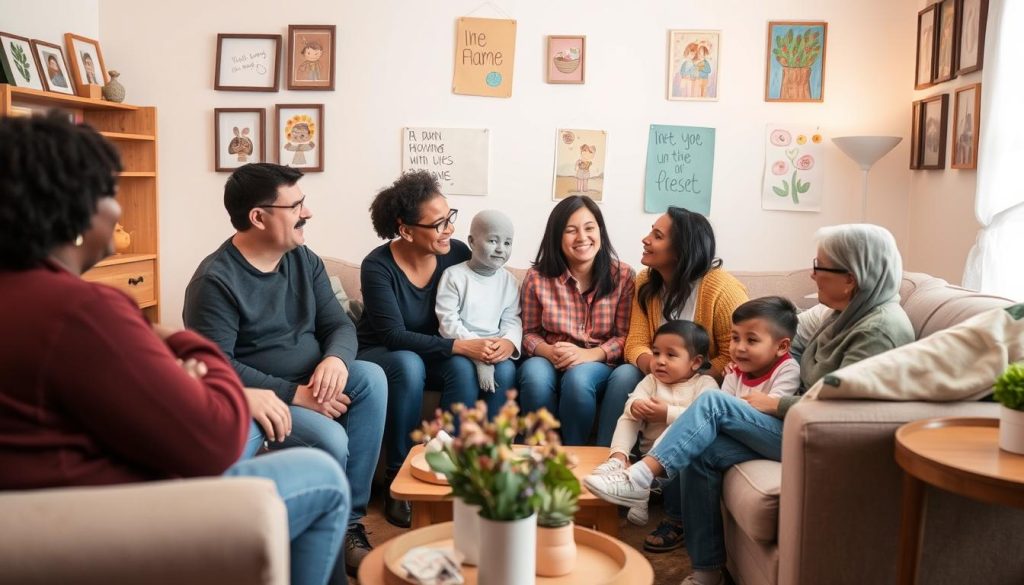Starting as a foster parent is a deep emotional journey. It’s filled with joy and challenges as kids get a chance to grow in a loving home. You’ll feel many emotions, like happiness, frustration, and sadness when they leave.
Getting tips and joining support groups can help a lot. They offer advice and a sense of community, making it easier to handle the ups and downs.
Key Takeaways
- The journey of foster parenting encompasses a wide emotional spectrum including excitement, fear, and frustration.
- Support groups and foster parenting classes are invaluable resources for managing emotional impacts.
- Nearly 55% of children are adopted by their foster caregiver.
- Adoptive families often experience a range of emotions, from excitement to frustration.
- Creating structure and routines is key for building attachments with foster children.
Understanding the Basics of Foster Care
The foster care system is key in child welfare, giving temporary homes to kids who can’t stay with their families. Many reasons for foster care exist, like safety issues or health problems with parents. Learning more about it helps debunk myths about adoption in foster care.
What is Foster Care?
Foster care means a child lives in a temporary home because they can’t stay with their parents. This might be due to safety concerns or health issues. The goal is usually to reunite the child with their family, but this isn’t always possible.
In 2018, over 437,283 kids were in foster care. More than 125,000 were waiting for adoption. The system tries to give these kids a stable home until they can return to their families or find a permanent home through adoption.
Difference Between Adoption and Foster Care
Adoption and foster care differ in their goals and lengths. Foster care is temporary, aiming for the child’s return to their family. Adoption is permanent, involving a legal change that gives adoptive parents full rights. Several factors influence these choices:
- Temporary vs. Permanent: Foster care is short-term, while adoption is lifelong.
- Legal Rights: Adoptive parents have full legal rights, unlike foster parents.
- Continuity of Care: Foster care might involve many placements, but adoption ensures permanency.
In 2018, over 63,123 kids were adopted from foster care. This shows how important adoption is in giving permanent homes.
Who Can Become a Foster Parent?
To become a foster parent, you must meet certain criteria and go through assessments and training. Here are some key points:
- Eligibility: Adults of various backgrounds, including single individuals, couples, and diverse ethnicities.
- Requirements: Home assessments, background checks, and training sessions to ensure suitability and preparedness for fostering.
- Commitment: Providing a safe, nurturing environment for a child for an indefinite period.
The need for foster parents is ongoing. Foster care adoption is often cost-effective, with many states offering financial help for the child’s needs.
Understanding the foster care system and the reasons for foster care helps clear up myths about adoption. It encourages more diverse and informed participation. Moving from temporary foster care to permanent adoption is crucial for children in need.
The Emotional Journey of Foster Parents
The emotional journey of foster parents is complex. It includes feelings of joy and stress. When a new child arrives, excitement and fear mix together. It’s important to understand and manage these feelings for your well-being.
Common Feelings Experienced
As a foster parent, you’ll feel many emotions. The emotional impact of fostering can be unpredictable. This can lead to anxiety and uncertainty. Yet, fostering can also bring great joy and fulfillment, especially when you see your foster child thrive.
The Role of Support Groups
Support groups are crucial for foster parents. They offer advice, shared experiences, and emotional support. Local and online groups provide a space to talk about challenges and get feedback. These groups can offer a sense of stability and shared experience.
Tips for Managing Emotions
Managing emotions requires a proactive approach. Prioritize self-care to handle the emotional impact of fostering. Enjoy activities, stay healthy, and get enough rest to reduce stress. Also, talk openly with your support network to process your feelings.
Joining foster parenting classes can provide valuable tools. These classes cover topics like grief and loss, and creating a supportive home. With knowledge and a strong support network, you can navigate the emotional challenges of foster parenting.
Preparing for a Foster Child’s Arrival
Welcoming a foster child into your home is a big step. It needs careful planning for a smooth start. Make your home welcoming, talk openly with your family, and get the right supplies for the child.
Creating a Welcoming Environment
Creating a welcoming space is crucial when adding foster children to families. Each child should have their own bed and maybe a separate room for privacy. If they share a room, keep it tidy and cozy.
It’s also important to ensure safety. Install smoke detectors on every floor and have a fire extinguisher ready. Make sure electrical areas are safe for kids and cover sharp corners. Keeping your home clean and organized helps the child feel at home.

Discussing New Changes with Family
Discussing adoption with children is key to prepare your family. Talk about empathy and support for the new foster sibling. Explain the role of fostering and involve them in the process.
Answer their questions openly. This helps everyone feel included and understand the importance of supporting the foster child.
Essential Supplies for Foster Care
Get ready for a foster child by gathering essential items. These include personal hygiene products, clothes, and toys suitable for their age. Some must-haves are:
- Toothbrush, toothpaste, hairbrush, towels, soap/shower gel, and shampoo/conditioner
- For teenagers, consider deodorant and feminine products
- Stock of diapers for babies
- Age-appropriate books, toys, and school supplies
- Personal space like a dresser and shelves for their belongings
- Keep medications and cleaning supplies locked away
- Childproof windows, doors, and electrical outlets
- Pack away fragile or sentimental items to prevent damage
Providing these basics helps the child settle into the foster home. Remember, setting up adoption arrangements early helps secure the child’s future.
Building Trust with Foster Children
Building trust with foster kids is key for their emotional and growth needs. Using good communication strategies, knowing their past, and making a connection are important steps. We’ll look at why communication matters, how to connect, and the importance of understanding their past.
The Importance of Communication
Good communication is the base of trust in foster care. It means listening well and making sure kids feel important. Dr. Karyn Purvis says it’s important to have positive talks, saying yes more than no. This creates a safe and stable place for them.
Strategies for Building a Connection
Building a bond with foster kids takes time and effort. Here are some ways to make that connection:
- Have a routine and be consistent: Regular times for meals and bed, and clear rules make them feel safe.
- Play together: Letting them lead and giving them your full attention helps build trust.
- Keep promises: Being reliable makes them feel secure and stable.
- Match their mood: Laughing and smiling with them helps you connect and build trust.
Eye contact is also very important in connecting. These methods help support foster teens on their unique path.
Understanding Their Background
Knowing about foster kids’ pasts, including any tough times, is crucial. Many have grown up in unstable homes. Being patient and letting them progress at their own speed is key. It’s important to make them feel accepted and valued, without being too strict.
| Trust-Building Strategy | Description | Benefits |
|---|---|---|
| Communication Strategies | Active listening, eye contact, and positive reinforcements | Fosters a sense of being heard and valued |
| Establishing Routine | Consistent meal times and bedtime routines | Creates a secure and grounded environment |
| Encouraging Play | Allowing the child to lead and following with undivided attention | Builds trust and attachment |
| Following Through on Promises | Demonstrating reliability and consistency | Instills a sense of security and stability |
The Ongoing Challenges in Foster Parenting
Foster parenting comes with many challenges. These include dealing with behavioral issues and managing relationships with biological families. It also involves addressing trauma. With over 400,000 children in foster care in the U.S., it’s key to understand these challenges to support them well.
Navigating Behavioral Issues
Behavioral problems in foster kids often stem from past trauma. It’s vital to use consistent discipline that meets each child’s needs. Therapeutic approaches are crucial, focusing on changing behavior and understanding the reasons behind it. Since about 40% of foster kids leave care within a year, foster parents must be ready to adapt quickly.
Managing Relationships with Biological Families
Foster parents must handle relationships with biological families with care. This is because about 54% of plans aim to reunite kids with their birth parents. Good kinship care means open communication and empathy. This helps ensure the child’s needs are met and can lead to smoother transitions and reunions.
Addressing Trauma and Its Effects
To tackle childhood trauma, foster parents need a trauma-informed approach. Data shows 20% of foster kids who were abused have PTSD symptoms. This approach includes being aware of triggers, offering counseling, and creating a supportive space. Understanding and addressing trauma is crucial for helping these children heal and grow resilient.
| Aspect | Challenge | Approach |
|---|---|---|
| Behavioral Issues | High due to past trauma | Consistent discipline and therapeutic strategies |
| Relationships with Biological Families | Maintaining respectful, cooperative interactions | Open communication and empathy |
| Addressing Trauma | High incidence of PTSD symptoms | Trauma-informed care and counseling |
The Role of Professional Support
Navigating foster care can be tough. Professional help is key for both parents and kids. It helps with emotional and behavioral growth. Knowing when and how to get help is vital for foster families.

When to Seek Therapy
Therapy is crucial for foster kids’ emotional needs. Experts help understand and manage trauma. If you see emotional or behavioral problems, get help early. It can greatly improve their life.
Valuable Resources and Organizations
Many groups offer great support for foster families. The Child Welfare Information Gateway has guides on foster care and laws. The National Foster Parent Association gives tools and advice.
Working with top adoption agencies gives you access to quality support. They offer workshops and seminars for foster care.
Educating Yourself About Trauma
Knowing about trauma in kids is key for foster parents. Trauma shows in different ways, and spotting it is crucial. Professional workshops and online courses teach you how to handle it.
| Resource | Service Offered |
|---|---|
| Child Welfare Information Gateway | Guides on foster care experiences, legalities, and child psychology. |
| National Foster Parent Association | Support tools, advice, and community for foster families. |
| American Academy of Child and Adolescent Psychiatry | Education on understanding trauma in children and therapeutic approaches. |
| AdoptUSKids | Resources on finding the best adoption agencies and fostering practices. |
Celebrating Milestones in a Foster Child’s Life
Celebrating birthdays, cultural events, and school achievements makes foster kids feel special. It shows them they belong in the family. By adding the child’s cultural traditions, we build respect and understanding. This strengthens our bond and keeps the child connected to their roots.
Acknowledging Achievements
Foster parents are key in celebrating foster care achievements. Seeing first steps and hearing first words is special. It helps foster kids feel like they’re part of a family.
These moments can be emotional, but they’re important. They help foster kids and their families grow closer.
Creating Lasting Memories
Creating memories is vital for foster kids’ emotional growth. Sharing birthdays and graduations as a family is key. It gives them a sense of stability and belonging.
It also strengthens the bond between foster parents and kids. Keeping in touch with biological families can also help the child thrive.
Incorporating Cultural Traditions
Respecting a child’s cultural identity is crucial. Adding cultural traditions to our lives and celebrations is important. It helps the child stay connected to their heritage.
This approach enriches our family life. It makes foster kids feel valued and connected to their roots.
Advocating for Your Foster Child
It’s very important to advocate for your foster child. This means knowing their legal rights in foster care, working with schools, and creating support networks. By being informed and active, you can help your foster child succeed in all areas of life.
Understanding Legal Rights
Foster parents need to know the legal rights of their children. In Pennsylvania, for example, foster care laws give foster parents the right to be heard and make decisions. Organizations like Family Care for Children & Youth (FCCY) provide training and support. They help foster parents understand these laws.
Legislative measures like AB 2830 make it easier for new foster parents to join. This is thanks to the Alliance for Children’s Rights.
Working with Schools and Teachers
Getting educational support for foster children is key. Foster parents should work with schools and teachers. This ensures their child gets the help they need.
The Alliance for Children’s Rights has helped over 7,000 kids and teens. They show how important it is to advocate for education. By keeping up with your child’s school progress, you can help them succeed academically.
Building a Support Network
Building a support network is crucial for foster children and parents. Joining groups, seeking therapy, and connecting with other foster parents helps. The Alliance for Children’s Rights trains thousands of people every year.
Events like the George Zajfen Tournament show the impact of community support. They raised $176,000 for foster kids and young adults. This highlights the power of community support.
| Organization | Key Contributions |
|---|---|
| Alliance for Children’s Rights | Trained over 10,000 partners annually, assisted 7,000+ children in education |
| Family Care for Children & Youth (FCCY) | Provides training and support, emphasizes cultural competence |
| Legislation AB 2830 | Simplified Resource Family Approval (RFA) process |
Transitioning from Foster Care to Adoption
The journey from foster care to adoption is filled with emotions and challenges. Knowing when adoption is right for your foster child is key. It’s also important to understand the adoption process and offer emotional support during this time.
Signs That Adoption Is Right
Figuring out if adoption is right means looking at the bonds with the foster child. If the child trusts and feels comfortable, it’s a good sign. Also, think about if you can meet the child’s emotional and developmental needs. Spotting these signs early can make the transition smoother.
The Adoption Process Explained
| Steps | Details |
|---|---|
| Initial Consultation | Meet with an adoption agency or caseworker to discuss suitability and next steps. |
| Home Study | Comprehensive evaluation of the prospective adoptive family’s home environment and lifestyle. |
| Legal Procedures | Filing for adoption, background checks, and fulfilling state-specific legal requirements. |
| Post-Placement Visits | Regular visits by a social worker to ensure a smooth transition and continued support. |
The adoption process starts with a first meeting and includes home studies and legal steps. It’s different for each child, especially in transracial adoption. Social worker visits after placement help the child adjust to their new home.
Emotional Support During Transition
Emotional support is vital for children adjusting to their new home. They might feel happy and sad at the same time. Building trust by slowly increasing contact with the adoptive family helps.
 Counseling and support groups can help with behavioral issues. Creating a Lifebook helps the child connect with their past.
Counseling and support groups can help with behavioral issues. Creating a Lifebook helps the child connect with their past.
The emotional support in adoption means starting with small steps like visits and calls. It’s important to understand and address any trauma, especially in transracial adoption. Being sensitive to the child’s feelings and involving them in the celebration helps build a strong foundation for their new life.
Self-Care for Foster Parents
Foster parents face unique challenges that make self-care crucial. It helps them stay well and effective. By using self-care tips and respite foster care, they can lead a balanced life.
The Importance of Personal Well-Being
Well-being includes emotional, physical, psychological, and social health. Keeping a journal, attending therapy, and setting work boundaries are key. These practices help maintain a healthy balance, essential for caring for foster children.
Techniques to Reduce Stress
Foster parenting is rewarding but can be overwhelming. Techniques like regular exercise, rest, and hobbies can lower stress. Respite foster care services also provide breaks. Building a support network through groups offers emotional support.
Finding Time for Yourself
Finding time for yourself is crucial amidst foster parenting demands. Enjoy activities that bring you joy, like spending time with friends or taking vacations. Make sure to have downtime and set boundaries to manage your responsibilities.
Here are some suggested self-care activities:
| Self-Care Activity | Benefit |
|---|---|
| Keeping a Journal | Helps in self-discovery and emotional balance |
| Attending Therapy | Provides professional emotional support |
| Setting Boundaries | Ensures a healthy work-life balance |
| Respite Foster Care | Offers necessary breaks for recharging |
| Spiritual Practices | Improves spiritual well-being and peace |
By using these self-care tips and respite foster care, foster parents can manage stress better. This leads to a more fulfilling and balanced life.
Combining Foster Care with Other Responsibilities
It’s tough to mix foster care with other life tasks, but it’s doable with the right plan and support. Good time management and getting relatives involved are key. They help meet both your and the foster kids’ needs.
Balancing Work and Foster Parenting
Managing work and foster care needs careful planning and flexibility. Since most foster carers don’t get paid, managing both jobs well is vital. Here are some tips to balance work and foster care:
- Setting Priorities: Know what’s urgent and important at work and home.
- Flexible Work Arrangements: Look for jobs that offer flexible hours or remote work to fit foster care needs.
- Supportive Employers: Find employers who get the challenges of foster care and offer support.
Involving Family and Friends
Getting family and friends involved in foster care helps a lot. It eases the pressure on foster parents. Here’s how to get them involved:
- Delegating Responsibilities: Give tasks to trusted family or friends, like picking up from school.
- Regular Check-Ins: Keep in touch with relatives to share updates and ask for help.
- Community Resources: Use local programs and after-school activities to help when you’re busy.
Time Management Tips for Success
Good time management is crucial for balancing foster care and work. Here are some tips:
- Schedule Routines: Create daily routines for meals, homework, and bedtime to keep things organized.
- Use Technology: Use apps and tools to keep track of your schedule and tasks.
- Self-Care: Make time for yourself to avoid burnout and stay energized for both work and foster care.
By using these strategies, you can manage your work and foster care duties well. A supportive network and good time management are key to success.
The Long-term Impact of Foster Parenting
Foster care can have a lasting positive effect on children’s lives. It helps them through education, emotional support, and stable relationships. Children in loving foster homes feel secure and belong.
These environments boost their emotional and psychological health. They grow into confident and resilient adults.
Positive Outcomes for Foster Children
Children in stable foster care often do better in school. They catch up on learning and love to learn more. Many go on to help others, working in social work or counseling.
But, some face challenges like trauma or mental health issues as adults. Support groups offer help through counseling and programs.
Building Lifelong Relationships
Foster parenting creates lasting bonds between children and their caretakers. These bonds last long after foster care ends. They provide ongoing support and help with identity growth.
These relationships are key to the child’s development. They show the lasting benefits of foster care, enriching lives and communities.
The Ripple Effect of Foster Care on Society
Foster care’s impact goes beyond individual lives. It makes communities stronger. Many former foster kids become active, self-supporting members.
Between 64% and 92% of them are self-supporting adults. They contribute to society through work and personal efforts. They also advocate for foster care, pushing for change.
This shows foster care’s wide-reaching benefits. It aims to create a caring society that supports every child.
FAQ
What is Foster Care?
Difference Between Adoption and Foster Care
Who Can Become a Foster Parent?
What Are Common Feelings Experienced by Foster Parents?
What Is the Role of Support Groups for Foster Parents?
Tips for Managing Emotions in Foster Parenting
How to Create a Welcoming Environment for a Foster Child?
How to Discuss New Changes with Your Family?
What Essential Supplies Are Needed for Foster Care?
The Importance of Communication with Foster Children
What Are Effective Strategies for Building a Connection?
Why Is It Important to Understand a Foster Child’s Background?
How to Navigate Behavioral Issues in Foster Parenting?
How to Manage Relationships with Biological Families?
What Are the Effects of Trauma on Foster Children?
When Should You Seek Therapy for Foster Children?
What Valuable Resources and Organizations Are Available?
How to Educate Yourself About Trauma?
Why Is It Important to Acknowledge a Foster Child’s Achievements?
How to Create Lasting Memories with Foster Children?
How to Incorporate Cultural Traditions?
What Are the Legal Rights of Foster Children?
How to Work with Schools and Teachers for Foster Children?
Why Is Building a Support Network Important?
Signs That Adoption Is Right for a Foster Child?
What Is the Adoption Process?
How to Provide Emotional Support During Transition from Foster Care to Adoption?
Why Is Personal Well-being Important for Foster Parents?
Techniques to Reduce Stress in Foster Parenting
How to Find Time for Yourself as a Foster Parent?
Balancing Work and Foster Parenting Responsibilities
How to Involve Family and Friends in Foster Parenting?
Time Management Tips for Success in Foster Parenting?
What Are the Positive Long-term Outcomes for Foster Children?
How to Build Lifelong Relationships with Foster Children?
What Is the Ripple Effect of Foster Care on Society?
This post contains affiliate links. If you click on a link and make a purchase, I may earn a small commission — at no extra cost to you. Thank you for supporting this blog and helping me keep the patterns free! Read the full Affiliate Disclosure & Transparency.
